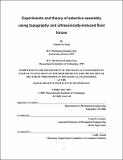| dc.contributor.advisor | Carol Livermore. | en_US |
| dc.contributor.author | Jung, Sunghwan | en_US |
| dc.contributor.other | Massachusetts Institute of Technology. Dept. of Mechanical Engineering. | en_US |
| dc.date.accessioned | 2007-08-29T19:07:48Z | |
| dc.date.available | 2007-08-29T19:07:48Z | |
| dc.date.copyright | 2007 | en_US |
| dc.date.issued | 2007 | en_US |
| dc.identifier.uri | http://hdl.handle.net/1721.1/38541 | |
| dc.description | Thesis (Ph. D.)--Massachusetts Institute of Technology, Dept. of Mechanical Engineering, 2007. | en_US |
| dc.description | This electronic version was submitted by the student author. The certified thesis is available in the Institute Archives and Special Collections. | en_US |
| dc.description | Includes bibliographical references (leaves 127-129). | en_US |
| dc.description.abstract | A site-selective self-assembly technique called templated assembly by selective removal (TASR) is introduced and demonstrated. A theory is created to describe its operation, and its correspondence with experiments is shown. In the experiments, the topography of the template is modified to match the shapes of micron-sized microsphere components at the locations where the components are intended to assemble; then the components and template are coated with a hydrophobic layer. The substrate and components are then placed in a fluid environment for the assembly process, and megahertz frequency ultrasound is applied to the fluidic bath to selectively remove components from undesired sites. Experiments successfully demonstrated highly selective assembly of the microcomponents with the diameters in the range from 1.6[mu]m to 0.4[mu]m into the shapematched holes in the template. Based on the understanding of hydrophobic interfacial energy and the flow fields created by ultrasound, a theory was proposed to describe the mechanism of component removal and was carefully verified with additional experiments. In the present work, scalability and repeatability of the present approach were also addressed and experimentally investigated. Additionally, component circulation was qualitatively assessed in association with near-boundary acoustic streaming flow, and its contribution to the present assembly process is discussed. | en_US |
| dc.description.statementofresponsibility | by Sunghwan Jung. | en_US |
| dc.format.extent | 150 leaves | en_US |
| dc.language.iso | eng | en_US |
| dc.publisher | Massachusetts Institute of Technology | en_US |
| dc.rights | M.I.T. theses are protected by copyright. They may be viewed from this source for any purpose, but reproduction or distribution in any format is prohibited without written permission. See provided URL for inquiries about permission. | en_US |
| dc.rights.uri | http://dspace.mit.edu/handle/1721.1/7582 | |
| dc.subject | Mechanical Engineering. | en_US |
| dc.title | Experiments and theory of selective assembly using topography and ultrasonically-induced fluid forces | en_US |
| dc.type | Thesis | en_US |
| dc.description.degree | Ph.D. | en_US |
| dc.contributor.department | Massachusetts Institute of Technology. Department of Mechanical Engineering | |
| dc.identifier.oclc | 165151378 | en_US |
